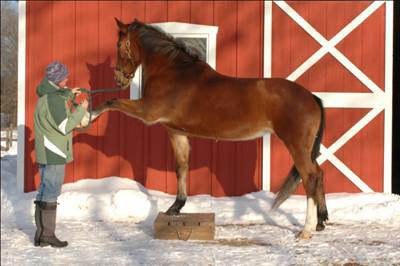|
EQUINE CLICKER TRAINING..... using precision and positive reinforcement to teach horses and people |
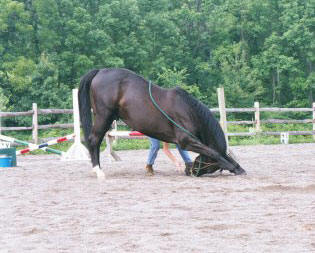

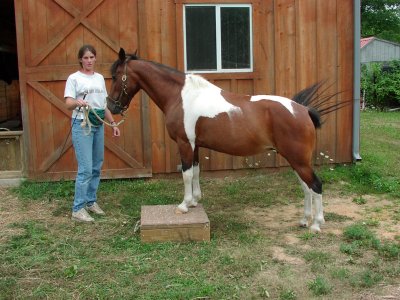
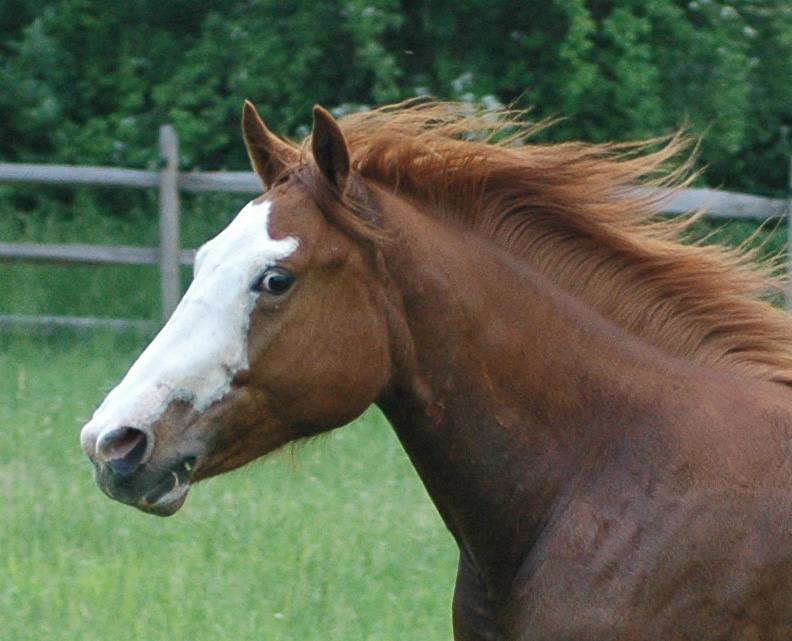
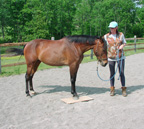
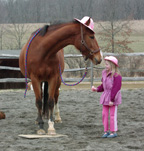
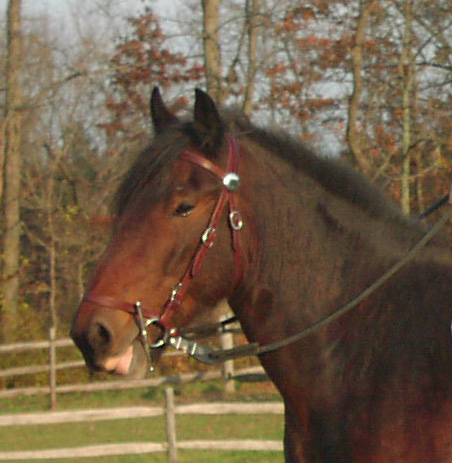
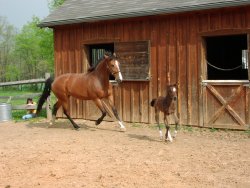 |
|
Matwork and its Applications (this was originally published in the German Clicker Magazine www.clickermagazin.ch in the spring of 2010. Mat work refers to teaching a horse to stand on a mat with its front feet, hind feet or all four feet. I first learned about it from Alexandra Kurland and it is one of her foundation exercises for her clicker training program. Mat work is really just a specific application of foot targeting, but it is so useful that it deserves to be treated as a separate lesson. Teaching a horse to stand on a mat might sound like a simple exercise for beginning clicker students, but it develops some very practical and powerful skills. Not only does teaching a horse to stand on a mat improve the trainer’s skills and teach the horse about how to play the clicker training game, it can be used as the basic building block for many other behaviors from ground tying to Spanish walk. In addition, mat work seems to create a positive emotional state for many horses. Horses like mats. They like to find a familiar mat in a strange place. Mat work can create more confidence about standing on different surfaces. If you teach your horse to stand on a mat and then on a raised mat or box, you can expect your horse to be happier about standing on other raised surfaces such as trailer ramps and pedestals. Some of the things I like about teaching mat work are that through the teaching process the horse and handler can learn many different skills, it creates a truly thinking horse, and you end up with a practical skill that you can then use in many different ways. It is a good first behavior for a cross-over horse because it is clearly defined, comes with a cue (the mat) and is not something that most horses have been taught, so there is less likely to be emotional baggage associated with it. In this article, I am going to share some strategies for getting started with mat work and what to do with it once you have the basics trained. I use mats all the time, for a wide range of horses, because I find it is a good building block for other behaviors and the familiarity of the mat work seems to add to a positive training environment. A variety of different types of mats can be used for mat work. My current favorite is a piece of plywood that is about 18 inches by 24 inches. The horses seem to enjoy the solid feel of the plywood under their feet and it is very portable. I have used other things in the past. A doormat can work well if it is not too flimsy. A flimsy doormat can get crumpled as the horse moves on and off so it requires repositioning. I think it is important that the mat is sufficiently different than the surface it is on, so that the horse can clearly tell when it is on the mat. Mats can be of varying sizes. I find that my 18x24 mat works for most horses. It is small enough that they have to work a bit to get both front feet on, but it is not so big that they get sloppy about foot placement. I have seen people use smaller mats, especially if they just want one foot on the mat, or bigger mats if they want to put all 4 feet on. I also have a box that is essentially a “raised” mat and I use this for more advanced work. There are a number of different ways to teach mat work and I think of them as being on a continuum with free-shaping on one end and leading the horse on to the mat on the other end. My goal is to help the horse be successful but without giving so much direction that he doesn’t have to think. What I usually do is start with free-shaping and then I adjust my approach as needed by adding in lead cues, targeting cues, or changing the environment. Throughout it all, what I am looking for is that moment when the horse sees the mat, and clearly says “oh, it’s about the mat!” and his eyes light up. So I am going to provide some direction when needed, but also step back occasionally because I want to let the horse figure out that the exercise is not about moving forward or back, or some other behavior, it is about the mat. Before I start on how to do the actually training, I want to say a few words about pawing. Pawing is a very natural response for a horse to do when it encounters a new object, especially one on the ground. It is a way for the horse to explore the object, just as we might pick something up with our hands. But pawing can also be a sign of stress or frustration and it is very self-reinforcing for some horses. If you ask a horse to interact with a mat, it is very likely that at some point, the horse is going to paw it. I used to just ignore pawing and let the horse figure out that pawing doesn’t work, but I found I could get into some interesting training issues where pawing became part of the behavior. So the horse would paw and then stand on the mat, or stand on the mat and then paw, or chain the behaviors together in some other way. Once pawing has been reinforced, it turns out that it can be very hard to extinguish. Part of the problem is that the trainer is looking for the horse to put his foot on the mat so the first time the horse does so, the trainer wants to reinforce it. But the first time a horse puts his foot in contact with the mat, he might already be thinking of pawing so pawing can accidentally get reinforced very early on in the training. The other part of the problem is that we are looking for foot movement so it is easy to click when we think the horse is getting ready to put a foot down on the mat, and instead it is starting to paw and we end up reinforcing that instead. For this reason, I am very careful about how I train mat work, especially with a horse that has shown it tends to paw. I never intentionally click pawing and I will interrupt the horse if it starts to paw. The easiest way to do this is to just remove the horse from the mat. I find that the horses figure out very quickly that if they paw the mat, they have to leave the mat and the opportunity for reinforcement. With this in mind, I usually start mat work with the horse on a lead, but with the intention of free-shaping standing on the mat with one or both front feet. Having the horse on a lead allows me to redirect the horse if he starts to paw, but otherwise I am going to let him experiment and I will communicate only by clicking. I think free-shaping the mat is a good exercise because the horse gets to choose how much he wants to interact with the mat and you can get good feedback on how well the horse understands the clicker game. Does he repeat what you just clicked? Does he try different things if he is not getting clicked? Free-shaping also allows the horse to explore what works (a foot on the mat) and what doesn’t work (pawing the mat, foot movement around the mat, other behaviors…) Free-shaping works well here because most horses that have been traditionally trained have no experience with mats. And most horses are curious so the mat is an item of interest and they want to interact with it. Because standing on the mat is a novel behavior, most horses don’t have any previous negative associations with this exercise. I like the exercise for new clicker horses because the mat itself provides a clear cue and the horse learns that when the mat is there, you might want him to stand on it, but it is not always available so you don’t get a lot of unwanted offered behavior. The presence of the mat itself adds a nice clarity to this early training. This initial session is an evaluation as much as a training session because I want to see what kinds of responses I am going to get. Depending upon how the horse does, I will continue with free-shaping or switch to using a target, using lead cues or using the “walkover” method. These are my four basic methods and there are ways each one can be customized for each horse. Usually what happens is that I use one method to start the behavior and then I use the other methods to improve the horse’s understanding of the mat. Alexandra Kurland taught me that the more ways you teach a behavior, the stronger it is going to be, so I like to be able to have the horse do mat work at liberty, on a lead and using a targeting cue. To start free-shaping matwork I am going to place the mat down and lead the horse up to the mat. Once we are near the mat, my role becomes more passive. My job is to click the horse for interacting with the mat and I going to shape a foot, or two (usually the front feet) on the mat. When I first put the mat into the space with the horse, it is likely that the horse will be curious and sniff it or look in its direction. So I start by clicking any interest in the mat. From there, I can start to reinforce any foot movement toward the mat. Once the horse has sniffed the mat, then a common response is to paw the mat. If the horse paws the mat, I will just walk the horse away and wait for a moment before returning to the mat Some horses will ignore the mat completely and not even seem to notice it is there while other horses will move their feet to carefully avoid stepping on the mat. If this happens, you can experiment with changing different variables. You can try a different kind of mat (doormat vs. wood or vice versa) or change to a bigger or smaller mat. You can set the mat up so it is a bit harder to avoid by placing it near a fence or wall. I never set it up so the horse only has the choice of going on the mat, but I will try to make it a bit harder to go around it in any direction. If the horse seems to ignore the mat, I might pick up the mat and put it back down which often catches the horse’s attention. Or I can put a known target such as a cone on the mat and reinforce the horse for touching the cone and then touching the mat near the cone. Another option is to use a hand held target to ask the horse to come forward and click if a foot touches near or on the mat. If you want to keep shaping without the lead, I think you have to be willing to experiment around a bit to see how you can make the mat more obvious or set the horse up so it is more likely to interact with it. But using the lead is another option and I sometimes take a more active role and direct the horse on to the mat. I want the horse to be successful and a horse that is ignoring or cautious about the mat might need some help. I can always go back and do free-shaping later. Using the lead to offer some direction can be easier and less stressful for some horses that are reluctant to offer behavior. I have two basic ways of using the lead. One is what I call the “walk-over” method and the other is using the lead to fine tune foot placement. Both of these methods teach the handler to use the lead to direct the horse’s feet on to the mat and they can improve your leading skills as well as the horse’s awareness of where its feet are. With some horses, I actually move to this step (using the lead) fairly quickly as I think that there is a little window of opportunity here, a chance to teach the horse to connect his feet to the lead, before the horse knows what the mat is about. This is especially true when you get to using the lead for final foot placement. I call this a “window of opportunity” because it is only available before the horse knows how to position himself on the mat on his own. This is because once the horse knows the point of the game is to put his feet on the mat and does it himself, you don’t need to use the lead to help him position anymore. I stated earlier that I have two basic ways I train mat work on a lead, the walk-over method and fine tuning off the lead. I started using the walk-over method when I trained a series of horses that wanted to paw the mat. I was working on a strategy for dealing with two common problems, the horse that paws and the horse that consistently avoids the mat. I decided that the simplest way of dealing with pawing was to just remove the horse from the mat every time he pawed and having the horse on a lead made this easier. I was also trying to come up with a better way to encourage a horse to step on a mat when it was clearly avoiding it. Some horses will move their feet around and you can click for foot movement, but they will carefully avoid actually putting a foot on the mat. These horses need to be desensitized to the mat a little. The walk-over method solved both these problems. In the walk-over method, I put the horse on a lead and walk the horse over the mat. It helps if I do this in an aisle or a narrower space, but I don’t like to restrict the horse too much. I want the horse to walk on the mat when he decides it is ok, not because there is nowhere else to walk. What I do is start walking the horse back and forth so he encounters the mat in his natural line of travel and he has to step over, on, or next to the mat. I usually start by clicking as we go by the mat. If the horse steps on it, that’s great. If the horse goes around it, then I click when a foot lands near the mat. I want to create a zone of reinforcement near the mat. If the horse is very concerned about the mat, I might click something else such as stopping and turning around and just let the horse get used to walking by the mat several times until the horse’s level of concern drops. At this point I am clicking for foot placement and feeding where the horse stops. Since we are walking, some horses will take a few steps after the click, especially if they are avoiding the mat. This is fine, and I am not going to worry about feeding on the mat yet. With some horses, I will actually encourage them to come forward away from the mat to eat. I do this if the horse is very concerned about the mat or I think it might paw. With a horse that has already had issues with pawing the mat, I purposely take them a few steps off the mat to feed them. The advantage to this is that it doesn’t give the horse the opportunity to practice pawing the mat. I have found that some horses will put a solid foot on the mat and then as soon as you feed them, they start pawing. So I don’t let the horse eat or ask it to stay on the mat until I have “stand on the mat without pawing” reinforced a number of times. Over time I will experiment with stopping and feeding on the mat. If the horse stands quietly, I click and treat a few times before moving on. If the horse paws, off we go. After I have walked forward and back a few times , what usually happens is that the horse starts to deviate less and less to avoid the mat and he will start to touch the mat with his foot as it passes by, or even just step on it. Once the horse is stopping with a foot on or very near the mat, I switch to using the lead to ask an individual foot to move and fine tune foot position. I learned this method from Alexandra Kurland who showed me how to use the lead, or the snap on the lead, to ask the horse to move his feet by starting with small weight shifts. Being able to shift the horse’s weight allows me to ask the horse to move a specific foot in a specific direction. My horse learns that I am asking for a very specific behavior (one foot moving in a specific direction for a specific distance) as opposed to just going forward and back. So if he stops with the left front on the mat, but the right front back, I can slide down the lead and put a suggestion in the line asking him to step up with the right front. I teach this with the mat as additional feedback for the horse. The horse’s primary information comes from my body language/feel on the line and initially I will click for a correct response to my lead cue. But once he starts to get the idea about moving a single foot in a single direction, I am going to only reinforce those foot movements that put the foot on the mat. I think having the mat makes it clearer to the horse that the directional information he gets from me is helping him be successful at putting his foot on the mat. It is a nice way to change the horse’s perception of what it means when someone asks him to move his feet. Here are some pictures of horses standing on the mat with their front feet. Rosie (left) has learned to stand square in front and put her ears forward to look pretty. Stella’s accomplishment is that she has both feet on and is relaxed. I have to say that we took the photos of Rosie on short notice in midwinter. She has both the winter fuzzies and a lack of conditioning, but she was happy to come out and show off her matwork.
Once I have the horse trained to put its front feet on the mat, I can teach the horse to put only its back feet on the mat or to put all four feet on the mat. If I have a horse that has learned to put its front feet on the mat, I don’t usually free-shape back feet on the mat at liberty as I find the horse will become frustrated. At this point, the mat has become a cue for placement of the front feet and the horse will keep offering that behavior. Instead I usually teach the horse to put its back feet on the mat using the lead. I can do this by putting the mat down behind the horse and teaching the horse to back on to the mat, or I can put the mat down under the horse and ask the horse to walk forward and bring its back feet on to the mat. I can also put the horse’s front feet on the mat, click and reinforce that, take the front feet off by walking forward, reinforce that, and then walk the back feet forward. When I am directing the back feet on to the mat, I am usually using Alexandra’s method of asking an individual foot to move through a change in the feel on the line, but I can also use a whip as an arm extender or free-shape back foot movement once the horse is close.
If I want to put all feet on the mat, then I start by getting the front feet on the mat and then asking the horse to move his back feet forward. I can free-shape this by reinforcing movement of the back feet or I can shape it by asking the horse to step up with his back feet using a whip or some other tactile cue. If you want to free-shape four feet on the mat, it helps to have a mat that allows the horse to stand comfortably on it with all four feet. An advanced exercise is to use a smaller mat and ask the horse to close his stance up more. If you want to free-shape that, it helps to have mats of varying sizes. Here is Rosie with 4 feet on a mat. She is standing on a raised box, but I trained her on a low mat first. She has also learned to close up her position and is offering it here. For smaller horses, they can stand on the raised box in a more normal stance which is a good first exercise on the raised box.
Once this basic mat work is trained, it is interesting to go back and see what the horse and handler have learned. The horse has learned about cues because the mat is a cue and the horse has also learned some foot placement cues through the process. I find that most horses have better leading skills if I have used the lead to teach mat work. The horse has become braver about experimenting with foot placement and offering behaviors in general. He has learned more about repeating what was clicked. The handler has learned how to break down behaviors and build criteria (first you click for foot movement, then you click for foot movement that puts the foot on the mat) and also that the process is just as important as the final result. But the final result is also a practical behavior that I can use as the foundation for lots of other behaviors. Once the horse knows how to put its feet on a mat, I can continue the process and use the mat to teach duration and stacked behaviors. Standing on a mat also has some practical applications. I have used it to teach horses to ground tie, stand in new and scary locations, and extended this concept of foot targeting to teach other behaviors involving foot placement. If you want to take mat work on to the next level, here are some things to explore: Duration: I can build duration so that the horse learns to stand while I do other things. An easy way to start building duration is to ask your horse a series of questions. Can you stay on the mat while I take a step back? Can you stay on the mat while I pat your neck? Back? Rump? Lift up a foot? Walk around you? Go pick up something? Once you get duration on the mat and the horse is comfortable with you moving around, you can turn this into ground tying. Generalize to other types of mats: once the horse has the basic idea of standing on one type of mat, will it stand on other mats? If you used a wood mat, can you use a doormat? Can you use a mat of a different size and shape? Can you use a raised mat? Can you use other materials such as a hula hoop to mark where you want the front feet? Zan learned to stand on a mat and then moved on to the raised box.
Add distance: can you send the horse to the mat? I’ll start to send the horse to the mat, usually by free-shaping going to the mat from a greater and greater distance. I might start by putting the mat next to the horse and reinforcing him for standing on it. Then I will lead the horse a short distance away, and shape the horse to go to the mat. Mats often seem to have magnetic qualities and horses will seek them out and go to them as soon as they spot them. Can you put it on cue? In most cases, the mat is the cue. I do make sure that the horse is reinforced for both going on the mat and for coming off the mat once I have the initial mat work established. I am ok if the mat is the cue, but I want to have the horse be polite about it, so I will add in some kind of release or body language cue that tells the horse when to go to the mat. In addition to this, I can use the mat to teach the cue “stand” and then use “stand” to ask the horse to stand in a specific location without a mat. The mat as a context cue: One of the things I like about using a mat is that I can teach the horse to do other behaviors while he is standing on the mat and the horse will not offer those behaviors unless he is on in position on the mat. The mat gives me a safe place to shape and practice behaviors that I don’t want the horse to throw at me off cue. A good example is teaching the leg lifts or jambettes for Spanish Walk. I taught one of my horses to do the leg lifts on the mat and she never offered them at other times. Once she was doing them well and on cue, then I started to ask in other locations but using the mat gave me an extra measure of safety. This works for any kind of behavior that can become a nuisance, such as nodding yes or no, smiling, taking off your hat, kisses, etc…
What I have found is that horses love mat work and you can use it to teach lots of different body movements. There are endless possibilities and I find that once horses understand they are going to be clicked for putting their feet on something, they eagerly play any mat games you can invent. As if this wasn’t enough reason to teach mat work, mat work seems to make horses braver and more confident. Horses that were tentative about odd surfaces or where they put their feet are now happy to put their feet on various surfaces. The presence of the mat seems to have a comforting effect on some horses, especially if you take the mat to a new location. The mat becomes a familiar friend in a strange place. My favorite mat story is from years ago when my mare Rosie was learning to canter over a small jump on the lunge. We were up in my ring and she was doing great when something spooked her as she went over the little jump. I let go of the line and she shot off the circle in a panic and I could see she didn’t know what to do. Then she suddenly veered to the side and stopped. I walked over to her and saw that she was standing on her mat. The presence of the mat gave her direction in her moment of panic and she was patiently waiting for me to come see her. Mat work really is amazing.
Home | Articles | Clicker Basics | Community | FAQ | Getting Started | Horse Stories | Links | Photos | Resources
|
||||





